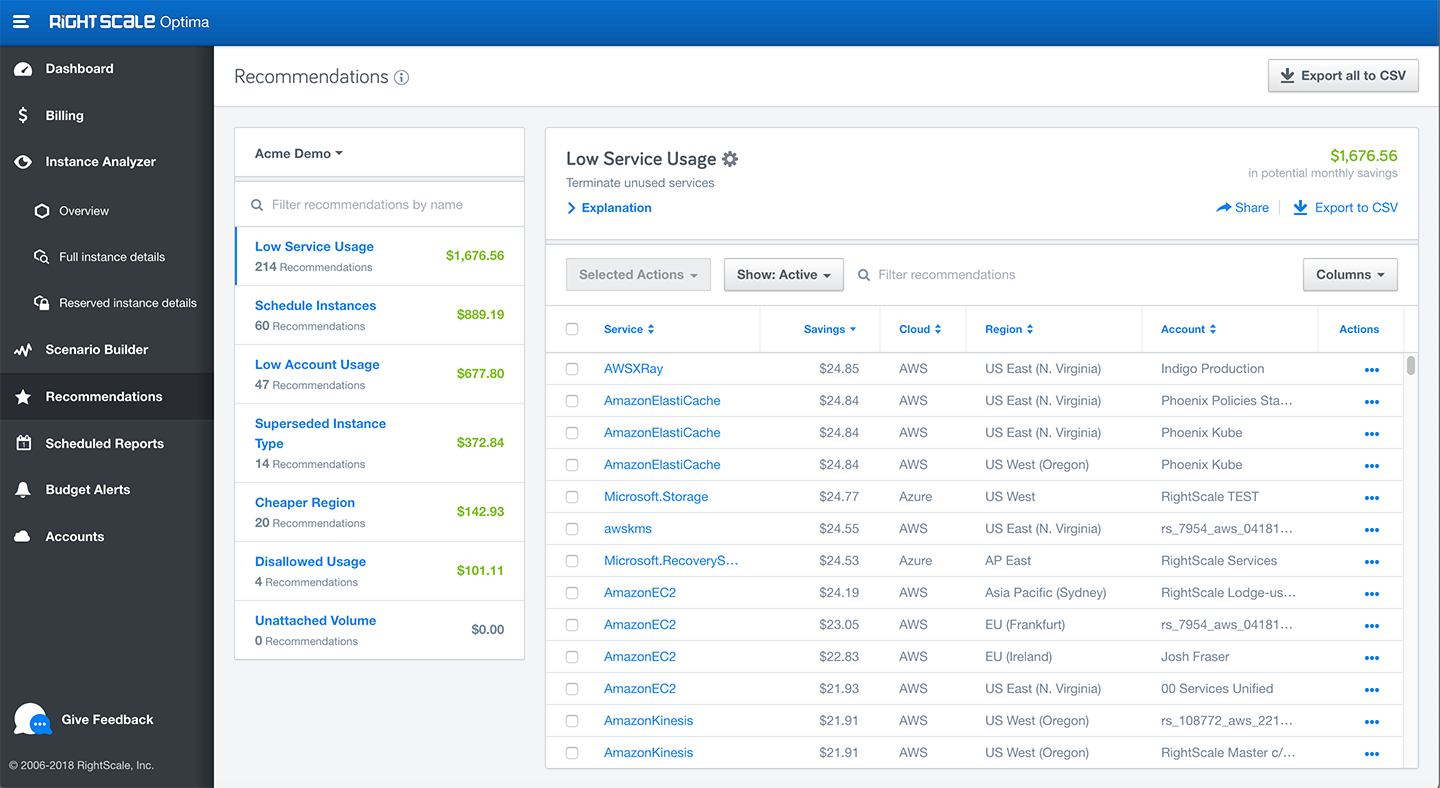 (Click image to enlarge)
(Click image to enlarge)
Overview
RightScale had made the corporate decision to pivot more strongly towards features around enterprise cloud cost adoption. As a result, management wanted to re-brand and relaunch our SMB-focused Cloud Analytics product. As part of this relaunch effort, they wanted to showcase new functionality that would offer value beyond basic graphs and charts. The product and UX teams were engaged to handle discovery and design for this important project. As the UX manager, I lead the efforts on UX research and design while overseeing a senior and a junior designer on the project.
Challenges
- As this was a completely new feature, we needed significant discovery and design efforts to understand customer needs and craft a strong solution.
- I needed to function as the lead UX/UI resource while also overseeing the two more junior designers assigned to the project.
- The project encompassed most RightScale departments, including marketing, sales, engineering, product, and services. Lots of communication was necessary.
- We needed to produce design assets for user research as well as marketing materials ahead of the launch.
Results
After significant design and discovery work, Optima was announced in April, 2017 and launched in July. The re-branding and recommendation engine brought new traffic to RightScale Marcom properties and increased our leads significantly for the next sales quarters, eventually leading to RightScale’s acquisition the following year. Our analytics KPIs showed that it was used by the vast majority of our existing enterprise customers in the first months.
For more information about Optima, see the marketing site and the documentation.
Process
Product took the lead on the initial discovery phase, and I joined with the PMs on several parts of this process. We began by gathering data from internal stakeholders who had close customer involvements (sales, services, marketing) and reached out to interview several customers about their challenges around cloud costs and to understand how we might extend our existing product.
With this data, I created a flowchart for expanding our cost management project and shared it internally, iterating based on significant feedback from product and engineering. I also constructed a journey map and iterated on it based on internal feedback. These two artifacts drove the next stage of the design process. I also worked with product management to develop initial KPIs. We brainstormed and whiteboarded with product managers, engineers, and the design team to identify potential features that aligned with customer needs.
To maximize the time of the other two designers on the project, I divided our designs into categories based on the flowchart. Each of us tackled different categories by making mocks in Sketch, then combining them into artboards and prototypes in InVision. These were first shared internally, and we conducted several iterations based on internal feedback. I then took the InVision prototypes to about 5 customers for usability testing, with other team members showing them to additional customers. We noted the results of the usability tests, and used the feedback to continuing iterating on the designs.
At this point, we knew that the scope of the designs were greater than the engineering resources to deliver within our timeline, so we narrowed the project back to the core recommendation engine that we had identified as delivering the most value for the Optima launch. Users wanted the ‘next level’ of cost management by see specific cost-saving actions and the associated savings. We also needed to integrate some aspects of our grouping idea in order for users to visualize cost savings by region, division, department, and other groups. We called this “Billing Centers”, though the initial MVP only let users group by cloud accounts (tags would come later).
We built a final InVision prototype and Confluence page for the MVP that we planned to release. My team and I worked closely with developers to ensure that the application being built matched the designs and solved for customer needs. I also configured our web analytics to track the metrics that we needed for the KPIs. We were able to show a beta version of the recommendation to select customers before releasing it publicly in July.
Following the successful launch which led to a 25% increase in qualified leads, we monitored local KPIs that we had set using Datadog and Heap Analytics. The data on Billing Centers showed extremely high adoption, hitting all of our KPIs. The Recommendation page showed a large percentage of our target segment visiting and viewing the recommendations, but few people taking actions on them. This led to several follow-up product interviews, where we learned that there were issues taking actions; the primary issue being the amount of manual work necessary. This directly influenced our product roadmap and led to the creation of another product which is documented in my portfolio: Governance Policies.
My artifacts and deliverables
- Discovery notes
- Recommendation system flowchart
- Recommendation system journey map
- 3 versions of Sketch designs
- Multiple InVision prototypes
- Confluence Wiki page
- KPIs and Heap analytics plans
- Usability testing write-up
- CSS code
Contact me if you are interested in seeing additional deliverables.